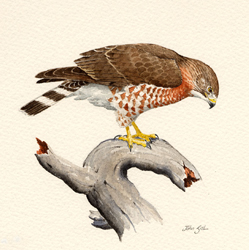Breeding Bird Atlases (BBA)
Find a Bird - BBA1
Breeding Bird Atlas 1 Species Accounts
Broad-winged Hawk
Buteo platypterus
Egg Dates
April 28 to June 21
Number of Broods
one

The Broad-winged Hawk is one of the commonest breeding raptors in the Commonwealth and is found wherever mature forest tracts of sufficient extent are located. It shows a distinct preference for deciduous or mixed woodlands and is equally at home in lowland valleys or hilly uplands. The Broad-winged Hawk was probably widespread in colonial times, but, as the land was cleared for agricultural purposes, it became an increasingly uncommon summer resident. With the decline in agriculture and gradual reforestation of the land, this hawk reoccupied its former territory and is now fairly common throughout much of the state but is scarce on Cape Cod and absent from the offshore islands.
The northward movement of Broad-winged Hawks through Central America can be spectacular because a great number pass through a restricted geographical area in a relatively short period of time. After moving through Texas, the flocks disperse over eastern North America. Normally, first arrivals are expected in Massachusetts in mid-April. The main migration occurs during the latter third of April or the first few days of May in late seasons, but the numbers encountered are never large.
Once a pair is on territory, the breeding cycle begins in earnest. Courtship displays are not spectacular, with circling and flapping just above treetop level constituting the basic activity. During these flights, the pair calls frequently, giving a plaintive, whistled pe-wee. The nest is located most frequently in a deciduous tree, although conifers are occasionally chosen. In many regions, the preference for Yellow Birch is so pronounced that the species is referred to as the Birch Hawk. In Massachusetts, nests have been recorded in Yellow Birch, Red Maple, Black Gum, White Pine, and Pitch Pine (CNR, MacDonald). The height of 9 Massachusetts nests ranged from 18 to 60 feet, with an average of 35 feet (CNR, MacDonald).
The nest is an untidy structure of twigs about 1.5 feet in diameter located in a main crotch or on a horizontal limb against the trunk. The inner cup is lined with strips of bark. Green sprigs are added throughout the nesting cycle. Clutches consist of one to three creamy white eggs, marked with blotches of various sizes and shapes. Incubation is mostly by the female and lasts for about 25 days. The young are fed an assortment of small mammals, birds, snakes, frogs, toads, and large insects. During the incubation and nestling stages, the adults spend much of their time in or below the forest canopy and also venture forth in search of prey in small clearings and along pond and stream edges. Nestlings are reported in June and July. At four or five weeks, the young clamber about the nest and adjacent branches accompanied by considerable wing flapping in preparation for the initial flight. When the young finally fledge at 41 days of age, they continue to be fed by the adults for up to two weeks, after which time they are able to seek prey on their own.
From the time the young are fledged until the first migrants begin moving south in the first days of September, Broad-winged Hawks become less conspicuous. During this period, they seldom vocalize and probably spend most of their time feeding and conserving energy for the long journey to the wintering quarters.
A growing number of enthusiasts staff hilltop vantages in anticipation of the southward flight, which usually reaches a peak between September 10 and September 20. Clear blue skies in the morning giving way to billowy cumulus clouds in midday indicate conditions when Broad-winged Hawks are likely to move. The sight of hundreds of hawks circling tightly and rising upward in a column of warm air until they are almost invisible is a sight not soon forgotten. On a good day, thousands can be viewed from favored locations such as Mount Tom or Mount Wachusett. By the end of September, most have departed the state. There are a few reliable sightings for November. With the exception of a small number of individuals found in southern Florida, Broad-winged Hawks winter in the southern portion of Central America and northern South America.
Map Legend and Data Summary
Atlas 1 data collected from 1975-1979


Note: fairly common in mature deciduous woodlands; absent on the Islands
Richard A. Forster



